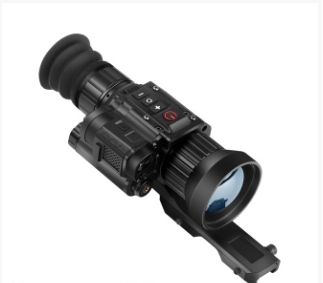Choosing the Perfect Rifle scope: Key Features to Consider
When choosing a Yubeen rifle scope, magnification stands out as one of the most vital features. It decides how near your target seems, shaping your precision and ease of aiming. A powerful zoom brings distant objects into sharp focus, perfect for sniping, but may shrink your sight picture, making fast-moving targets tricky to follow. On the flip side, lower magnification opens up a wider view, which shines in close-quarters or fast-paced shooting.
For tactical missions and spotting far-off threats, high-tech gear like the FX50L thermal imaging system shows why magnification is key. Packed with a crisp 640×512 uncooled sensor and ultra-fine 12μm pixel pitch, it delivers smooth thermal visuals at 50Hz, backed by a sharp 35mK NETD sensitivity.It’s 2.6x base zoom lets users spot threats up to 2,600 meters while staying adaptable. This harmony between zoom and field of view is a game-changer for pros in high-stakes situations.

Which Magnification Fits Your Shooting Style?
Different distances call for different scopes. Here’s a quick guide:
Close-Range (Under 100 yards): A Yubeen rifle scope with mild magnification (1x to 4x) is your best bet. It offers a generous sight picture and lightning-fast target lock.
Mid-Range (100–300 yards): A mid-power scope (4x to 9x) strikes the right balance—enough detail for accuracy without losing awareness of your surroundings.
Long-Range (300+ yards): Here, high magnification (10x or more) is non-negotiable. It’s the secret to nailing distant shots with confidence.
The FX50L proves how smart engineering meets long-range demands. Its 50mm F1.0 lens serves up an 8.783°×7.032° view and focuses as close as 5 meters. Whether the target is a mile away or just steps ahead, this system keeps you ready.
Why Lens Quality Can Make or Break Your Shot
Clear glass is the unsung hero of precision shooting. A top-tier lens cuts through distortion and pulls in every drop of light, so your aim stays true even when conditions turn tough.
Take the FX50L’s optics—crafted from germanium, they suck in light like a sponge, serving up razor-sharp details. When you’re scanning a cluttered landscape or picking out a target at the edge of vision, this clarity is priceless.
Lens Coatings: Your Low-Light Lifesaver
Ever struggled to see through glare or murky twilight? Lens coatings are the fix. They slash reflections, boost brightness, and sharpen contrast, turning dim scenes into workable views. Anti-reflective layers, for instance, act like invisible helpers, channeling more light to your eye.
The FX50L thrives in the dark thanks to its high-sensitivity microbolometer and precision optics. For night ops or shadowy environments, gear like this is a must-have.
Reticles and Adjustments: Fine-Tuning Your Aim
Reticle Rundown:
Your crosshairs aren’t just lines—they’re tools. Duplex reticles keep things simple, ideal for casual hunts. Mil-dot versions add dots for gauging distance and wind. BDC reticles compensate for bullet drop, while lit-up crosshairs cut through gloom.
Windage and Elevation:
These dials let you tweak your aim horizontally and vertically. Nail them, and your bullet lands exactly where you want, regardless of wind or gravity’s pull.
The FX50L embodies this precision. Compact yet mighty, it pairs pro-grade detection with intuitive controls, so you adapt on the fly.
Built to Last: Durability You Can Trust
A flimsy scope fails when you need it most. Weatherproofing shields against rain, fog, and dust, while shock proofing shrugs off recoil and bumps. For heavy-caliber rifles or rough terrain, these features are non-negotiable.
The FX50L doesn’t cut corners. Its rugged frame houses a 640×512 micro bolometer with <35mK sensitivity, ensuring crisp imaging shot after shot. Tactical users swear by this reliability.

Eye Relief: Where Safety Meets Comfort
Why It Matters More Than You Think
Firing a high-recoil rifle without proper eye relief is like driving without a seatbelt—it only takes one unexpected jolt to regret it. When that kickback hits, a scope mounted too close can rocket toward your face, leaving you with more than just bruised confidence. Generous eye relief acts as your buffer zone, keeping the eyepiece at a safe distance while maintaining a crystal-clear sight picture. It’s not just about avoiding a black eye—it’s about staying in the fight without flinching.
The Goldilocks Zone of Shooting Comfort
Too close, and you’re straining to see; too far, and the image turns into a tunnel. The magic lies in finding that “just right” spacing where your eye naturally settles into position. With optimized eye relief, you won’t waste time squinting or wrestling with awkward head positions. Instead, you’ll maintain a relaxed posture, shot after shot, even during extended sessions.
Take the FX50L’s design as a masterclass in balance: its 50mm F1.0 lens and 2.6x magnification create a visual sweet spot—wide enough to sweep for threats like a floodlight, yet sharp enough to pick out a target’s heat signature at 2,600 meters. Whether you’re scanning a hillside or engaging at point-blank range (thanks to its 5m minimum focus), your eye stays comfortable, and your focus stays lethal.
Pro Tip: For heavy-recoil calibers (think .300 Win Mag or .50 BMG), prioritize scopes with 3.5–4 inches of eye relief. Your cheekbone will thank you.
Q&A:
Q1: How to pick magnification?
A: Choose magnification based on your usual shooting range. For short distances like dense woods or close-range targets, go with low magnification (1x–4x). Medium ranges (4x–9x) suit general-purpose use like hunting or range shooting. For long distances, such as precision shooting or open terrain, high magnification (10x and above) helps you see and aim at far targets. Pick what fits your most common scenario.
Q2: Do coatings matter?
A: Yes, lens coatings are essential. They reduce glare, improve light transmission, and boost image clarity, especially in dim lighting. Coated optics provide a sharper, brighter view and are more comfortable on the eyes during long use. Multi-coated lenses perform even better in harsh conditions.
Q3: What’s parallax adjustment?
A: Parallax adjustment ensures the reticle stays aligned with the target, even if you move your eye slightly. Without it, your point of aim could shift, especially at higher magnifications or longer distances. This feature helps eliminate aiming errors and increases accuracy, making it especially important for precision shooters. Look for scopes with side focus or adjustable objective lenses if you want fine control.

